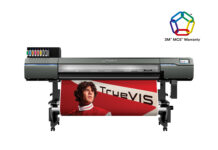While the gradual return of more favorable market conditions and improved business confidence is a welcome relief from the post-2008 years, the challenge for sign makers and wide format printers now is to maintain the disciplines, customer focus, and progressive initiatives that enabled their survival.
Many companies have emerged leaner and fitter from the Great Recession, but it’s also probably fair to say that major investment decisions, put on hold during the years of frugality, have remained on the “to do” list.
A look at market trends and the possible future of the sign and wide format market is critical for companies forming strategies that will shape their investment choices.
This is where in-depth discussions with leading industry hardware and software suppliers can prove to be highly valuable. Contrary to the hype for new media and technologies, like digital signage, the sign and display market’s future looks good, but it will not be a simple extension of the present.
A Challenging But Bright Future
Consider the products that are currently the staple output of your company.
Among them may be vehicle [wraps], street banners, feather flags, café barriers, and colorful floor graphics. How many of these were produced twenty years ago?
There is no reason to believe the next decade or two won’t bring another wave of new applications.
The migration from screen to digital has brought many changes but even more opportunities for very short runs, lower cost production, and applications on a greater range of substrates. Small companies, schools, organizations, and other enterprises that had never bought anything more than basic signs are now buying colorful and creative banners, displays, and other applications.
To serve these new customers, sign makers and display printers had to get out of their comfort zones and make the investments and mind-set changes necessary to respond to these new market opportunities.
Is Your Equipment Working to Its Potential?
Part of remaining competitive in the future will mean stepping out of your comfort zone, and part of that process is recognizing what you already have the potential to do. This need not require capital investment, but it is about having the ability to be flexible and get the most from your existing resources.
On the hardware side, refreshing your familiarity with the features of your printers and cutters that you aren’t using can reveal opportunities. Who would benefit from applications utilizing unused features? If there isn’t an existing market for them, can you create one?
Another coming development to watch will be the emergence of niche application solutions. The inclusion of RIP and design software in printer packages is becoming increasingly common. With application-specific, end-to-end solutions, new markets can be entered providing quick, local production of high-value products.
Solutions for road and industrial signage, wall coverings, digital textile printing, and even printing on wood and glass are either already here or will be in the near term.
Don’t Turn Your Back on the Tried and True
Of course, new applications and markets don’t mean abandoning old skills and techniques but [instead] furthering them with the right choice of equipment, software, and media.
Data gathered from SAi Flexi users worldwide shows that 56 percent of all signage jobs use cut vinyl. What this figure demonstrates is that, after twenty years, digital printing has not become a replacement technology for vinyl but has expanded the market and created new opportunities.
One of the reasons for vinyl’s enduring dominance is that handling and cutting has become easier and more efficient. Optimum imposition to minimize waste and fast, accurate cutters continue to make the use of vinyl affordable and profitable. Weather and abrasion resistance are other factors that make vinyl attractive to sign makers and customers.
There is no doubt that sign making and wide format print markets will change—possibly dramatically—in the coming years. Apart from technological and economic factors, issues like environmental regulations, distribution logistics, energy, and others will impact businesses.
These changes and issues will not only create challenges but also opportunities for those who recognize them. The leading suppliers can work with businesses of all sizes and specialties to explore new technologies and revenue streams to build a secure future.
By Stephanie Stamm, U.S. marketing manager at SAi, a provider of professional software solutions from design to production.
Photo:











